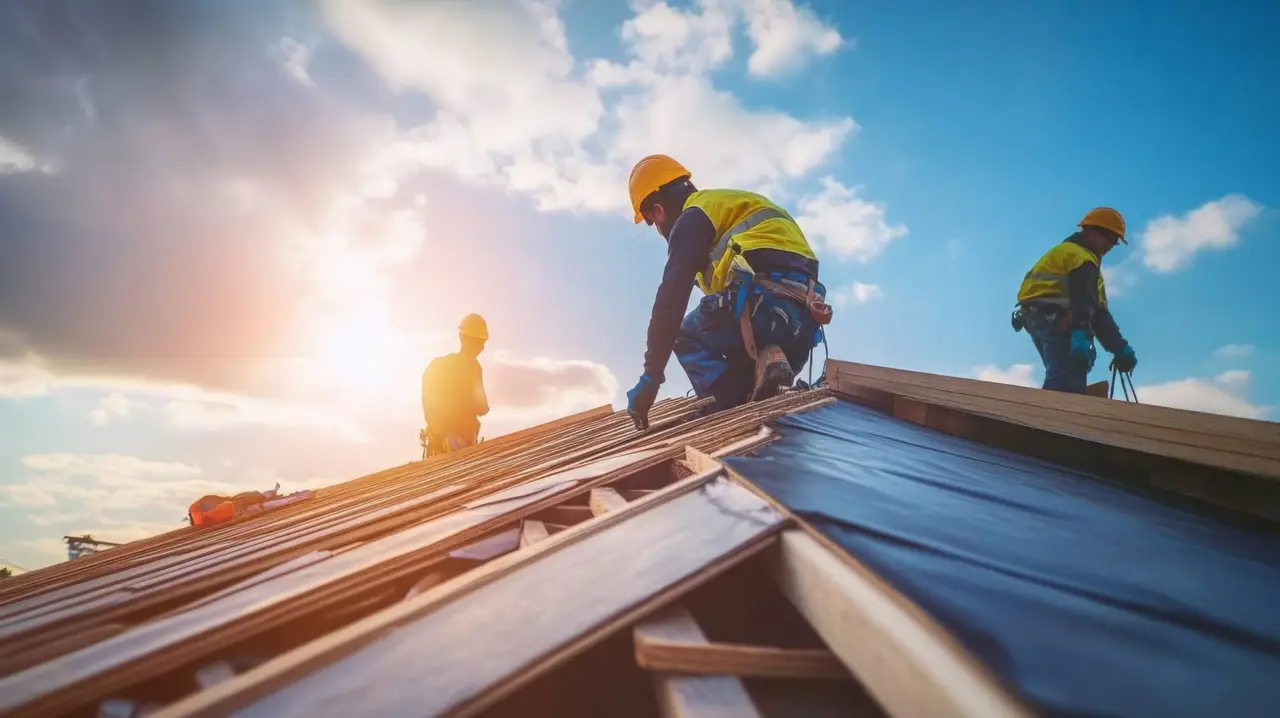Have you ever wondered why your attic feels like a summer sauna or ice dams form on your roof in winter? These issues often point to a common problem: poor roof ventilation. At Roof Rescue, we’ve seen how proper ventilation transforms a home’s comfort and longevity. But what is roof ventilation, and why should homeowners care?
Roof ventilation allows air to circulate through your attic space. This airing balances air intake at the eaves and exhaust near the roof peak. This process maintains your home’s structural integrity, energy efficiency, and indoor comfort. We’ll explore roof ventilation, helping you understand how it can benefit your home.
The Importance of Roof Ventilation
Imagine your roof as the lungs of your house, breathing in and out. This airflow maintains a healthy home environment and protects your investment.
Let’s break down why roof ventilation is so important:
- Energy efficiency: A well-ventilated roof regulates your home’s temperature year-round. In summer, it prevents attic heat buildup, easing your AC’s workload. It maintains consistent roof temperatures in winter, warding off ice dams and lowering heating bills.
- Roof lifespan: Heat and moisture are roofing material’s worst enemies. Good ventilation extends your roof’s life by stopping water buildup and temperature swings.
- Indoor air quality: Stale attic air breeds pollutants, allergens, and odors. Proper venting circulates fresh air through your home, promoting a healthier living space.
- Moisture control: Effective ventilation manages humidity, mold, mildew, rot, and structural damage. It’s essential for protecting rafters and sheathing from wood rot.
Poor roof ventilation problems lead to early shingle wear, high cooling costs, and potential health risks from bad air quality. A well-ventilated roof provides a healthy, energy-efficient home.
Signs Your Home Needs Better Roof Ventilation
Your roof might be crying out for help, but are you listening?
Here are signs your roof ventilation needs attention:
- High energy bills: Climbing heating or cooling costs may signal poor roof ventilation. When your attic overheats in summer, it forces your AC to work overtime.
- Ice dams in winter: Those scenic roof icicles may charm, but they signal poor ventilation. Ice dams form when heat escapes into the attic, melting snow on the roof and refreezing at the colder eaves.
- Excessive attic heat: On a hot day, your attic should be warm but not scorching. If you can’t stand in your attic for over a few minutes in summer, you likely have a ventilation problem.
- Attic moisture: Dampness, water stains, or visible mold in your attic show poor airflow. Unchecked moisture can cause structural damage.
- Peeling exterior paint: Poor attic ventilation traps moisture in walls, causing exterior paint to bubble and peel.
- Damaged shingles: Excessive attic heat can curl, crack, or strip protective granules from your shingles.
- Indoor discomfort: Uneven temperatures throughout your house may result from lousy roof venting.
If any of these signs sound familiar, you may be experiencing poor roof ventilation problems—it’s time to look at your roof’s ventilation system. Catching these issues early saves you from costly repairs.
Types of Roof Ventilation
Not all vents are equal. The right choice depends on your roof’s design, local climate, and ventilation needs.
Let’s break down common types of roof ventilation:
- Ridge vents: Run along your roof’s peak, offering sleek exhaust ventilation. Almost invisible from the ground, they’re popular with aesthetics-conscious homeowners. Ridge vents use natural convection, letting the hottest air escape at the roof’s highest point.
- Soffit vents: These intake vents sit under the eaves, allowing fresh air into the attic. They provide cool air that pushes hot air out through exhaust vents. Soffit vents come in continuous or individual styles.
- Gable vents: These vents sit at the ends of your attic. They can draw air or push it out based on the wind blowing. While helpful, gable vents often don’t work as well as a mix of soffit and ridge vents.
- Powered attic ventilators: Electric fans remove hot air from your attic. Poor installation can cause problems by drawing conditioned air into the attic.
- Turbine vents: These wind-driven vents spin to remove hot air and moisture. It is practical in windy areas but less so in calm conditions.
Each vent has its pros and cons:
- Ridge vents offer excellent coverage and a clean look but may be more expensive.
- Soffit vents are crucial for proper intake but can be prone to clogging if not maintained.
- Gable vents are easy to install but need more airflow for larger attics.
- Powered ventilators can move much air but come with energy costs and potential back-drafting issues.
- Turbine vents are cost-effective but may be noisy and less aesthetically pleasing.
Your ventilation system may involve a mix of these types tailored to your home’s needs and design.
How Roof Ventilation Works
Roof ventilation relies on a simple principle: rising hot air creates a natural flow that keeps your attic dry and temperate.
Here’s the process:
- Intake: Cool air enters through vents at the roof’s lowest part, usually soffit vents under the eaves.
- Circulation: This cool air warms up in the attic due to heat from the sun and living spaces below.
- Exhaust: Warm air rises and escapes through vents at the roof’s peak, typically ridge vents or other high-placed openings.
Two forces drive this air movement:
- Thermal effect: Rising hot air creates a current that pulls cooler air from below.
- Wind effect: Wind over the roof creates pressure differences, enabling airflow through the attic.
Ventilation requires a balanced system. The right mix of intake and exhaust vents is crucial. Too much of either can disrupt airflow and reduce ventilation efficiency. Your roof design and local climate determine the ideal vent combination and placement.
Calculating Your Home’s Ventilation Needs
Roofing experts suggest 1 square foot of ventilation per 300 square feet of attic floor space. You should split this ratio between intake and exhaust vents for balanced airflow.
But your home’s ventilation needs will vary based on several factors:
- Climate: Hot, humid areas demand more airflow than cool, dry regions.
- Roof design: Pitch and complexity influence airflow patterns.
- Attic insulation: Better insulation may reduce airflow demands.
- Home size and layout: Larger or more complex houses require additional airflow.
- Moisture history: Past humidity issues call for better air circulation.
These variables make professional assessment a needed step in roof maintenance.
Benefits of Proper Roof Airflow
Investing in proper roof airflow offers immediate and long-term benefits for your home.
Extended Life
Good airflow prolongs your roof’s lifespan. It controls attic temperature and moisture. This circulation cuts wear and tear by reducing the expansion and contraction of materials. A dry attic also prevents mold and mildew that rot wood structures.
Lower Energy Bills
A well-aired attic stays in summer and eases your AC’s workload. Expect savings on energy costs during peak cooling months. In winter, sound airflow retains constant roof temps, stopping ice dams and heat loss.
Indoor Comfort
Attic airflow creates consistent temperatures throughout your home. Year-round, you’ll enjoy fewer hot and cold spots and a cozier living space.
Moisture Protection
Airflow guards against attic dampness. It helps prevent wood rot, mold growth, and insulation breakdown. Your stored items also stay safe from moisture damage.
Fresher Air
Good airflow removes stale air, odors, and pollutants, improving air quality. It benefits those with respiratory issues or allergies.
Code Compliance
Many local codes require proper attic circulation. Meeting these standards prevents issues when selling or renovating your property.
Increased Value
A maintained roof with good venting attracts buyers, boosting your home’s worth.
Ventilation Mistakes to Avoid
Knowing common errors will help you sidestep costly blunders:
- Smothering vents with insulation: Don’t cover soffit vents while insulating. Blocking these crucial air intakes disrupts your entire ventilation system.
- Combining vents: Mixing exhaust vents (like ridge and gable) can create airflow short-circuits, hampering effectiveness.
- Skimping on intake vents: Many roofs have enough exhaust but need proper intake. This imbalance leads to poor circulation and may pull conditioned air from living spaces.
- Overdoing it: More vents are sometimes better. Excessive ventilation can reduce energy efficiency and cause moisture issues in some climates.
- Ignoring upkeep: Vents clog with dust, debris, and even pests. Regular cleaning keeps your system running.
Avoid these pitfalls to boost your roof’s performance and longevity. Unsure about your setup? Consult a pro for design and maintenance advice.
When to Consult a Professional
While some home upkeep is DIY-friendly, roof ventilation demands expert skills. Call a professional when:
- You notice poor ventilation signs like high energy bills, ice dams, or attic moisture.
- You’re planning a roof replacement or major renovation.
- You need to figure out your current ventilation system’s performance.
- Your attic’s heat or humidity levels have changed.
- Your home has unique features that complicate ventilation.
At Roof Rescue, we’ll give your roof a thorough check-up and design a ventilation. We use advanced tools to measure airflow, detect hot spots, and pinpoint issues.
Invest in Your Home’s Health with Proper Roof Ventilation
Your roof isn’t another home upkeep task—it’s the key to a healthier home. The benefits are a longer roof life, enhanced comfort, and lower energy bills.
We’ve explored ventilation issues, vent options, and common mistakes. But every home is unique. Local climate and your house’s design often need expert assessment for optimal results.
Ready to refresh your home? Request a free estimate from Roof Rescue today. Our team will check your roof and design an airflow system for lasting comfort and efficiency.
Mark Franklin, owner of Roof Rescue in Idaho Falls, Idaho, has been a trusted name in roofing since 2014. Serving Idaho, Montana, Wyoming, and Utah, Roof Rescue specializes in commercial and residential roof replacement and installation. Recognized for community initiatives like the “Operation Roof Rescue” program, which provides free roofs to local heroes, Mark combines professionalism with a passion for giving back. With 16 years of industry experience, an A+ Better Business Bureau rating, and glowing customer reviews, Mark’s leadership embodies quality and community-focused service.



